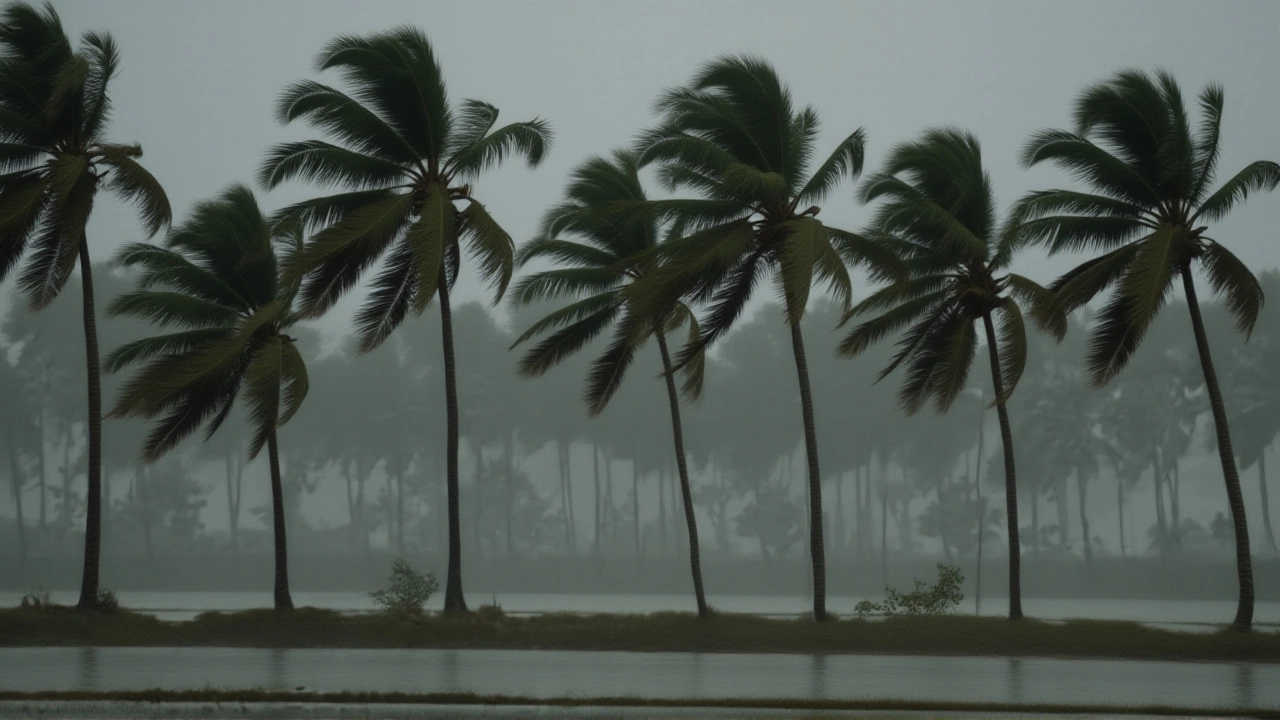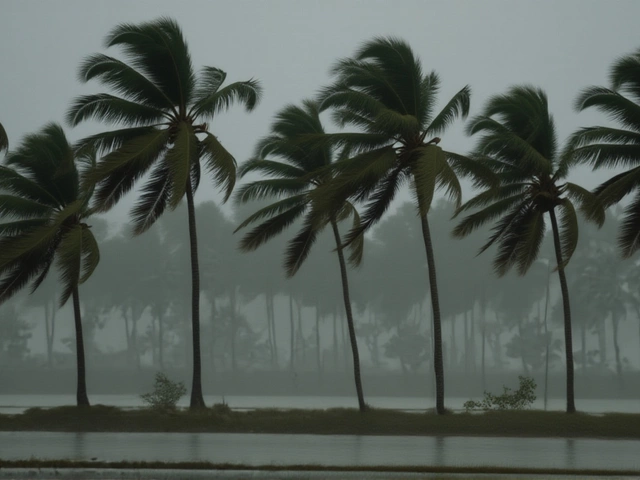When India Meteorological Department issued its final alert on October 29, 2025, Cyclone Montha had already carved a path of destruction across India’s eastern seaboard. The storm made landfall between Machilipatnam and Kalingapatnam in Andhra Pradesh, dumping torrential rain, toppling trees, and knocking out power to over 2 million homes. Two people died in the state, and nearly 150,000 acres of standing crops — mostly rice and cotton — were washed away. What made this storm dangerous wasn’t just its wind speed, but how long its remnants lingered, turning inland districts into lakes.
Landfall and Immediate Aftermath
Cyclone Montha struck at 10:45 p.m. IST on Tuesday, October 29, with sustained winds of 110 km/h and gusts hitting 135 km/h. It had intensified into a severe cyclonic storm just hours before, with ocean swells reaching 5 meters (16 feet). The eye passed just south of Kakinada, carving through the West Godavari district before weakening rapidly over land. By 5:30 p.m. the next day, the India Meteorological Department confirmed the system had degraded into a depression, moving northwest at 18 km/h toward Chhattisgarh.
Emergency teams scrambled. In Odisha, Chief Minister Mohan Charan Majhi announced that 11,396 people had been evacuated to 412 relief centers. The Odisha Disaster Rapid Action Force deployed 30 teams, while five National Disaster Response Force units were sent to Andhra Pradesh. Over 55 trains were canceled across four states. More than 500 people were pulled from flooded homes in coastal Andhra, Tamil Nadu, Bengal, and Odisha.
Widespread Damage Across Four States
The damage wasn’t confined to the coast. Telangana saw record-breaking rainfall in Hyderabad and Warangal, with some areas receiving over 250 mm in 12 hours. In Vidarbha and Marathwada, rivers overflowed, submerging farmland and cutting off roads. In Chhattisgarh, the storm’s outer bands triggered landslides in the Bastar region, isolating villages.
Andhra Pradesh bore the brunt. Power lines snapped in Vijayawada and Guntur. Mobile networks went down in 17 mandals. The state government reported 1,200 homes damaged, with 87 completely destroyed. In coastal villages like Narsapur and Tuni, entire neighborhoods were underwater. Farmers lost not just crops, but seed stocks for the next season — a blow that could ripple into next year’s food prices.

Alerts Expand as Storm’s Remnants Shift North
Even as Montha weakened, its moisture plume didn’t. By October 30, the India Meteorological Department issued an orange alert for Bihar and Saurashtra-Kutch, warning of “very heavy rainfall” over the next 24 hours. Yellow alerts covered eastern Uttar Pradesh, Jharkhand, West Bengal, and parts of Madhya Pradesh. The forecast was grim: moisture from the Bay of Bengal was being sucked northward by a developing low-pressure system over central India.
“This isn’t over,” warned Dr. R. S. Prasad, a senior meteorologist at IMD. “The system is now acting like a moisture pump. Even without wind, the rain will keep falling — and that’s what causes the most damage.”
By Wednesday evening, the storm’s center was over southern Chhattisgarh, moving toward Madhya Pradesh. The IMD predicted it would become a low-pressure area within 12 hours — but not before dumping another 100–150 mm of rain across the region.
Why This Storm Was Different
Montha wasn’t the strongest cyclone this season — that was Tauktae in 2021. But its timing was brutal. It hit just after the kharif harvest was nearly complete, wiping out the last of the season’s crops. Unlike earlier storms that moved quickly inland, Montha slowed down over land, lingering for nearly 18 hours before fully dissipating. That extended exposure turned flash floods into prolonged inundations.
Also, the storm’s path crossed multiple agricultural belts. Andhra Pradesh’s coastal plains, Telangana’s rain-fed zones, and Vidarbha’s cotton fields — all hit at once. The economic cost? Experts estimate at least ₹1,800 crore ($2.3 million) in agricultural losses alone.

What’s Next?
The immediate priority is restoring power, clearing roads, and distributing clean water. The National Disaster Response Force says it will remain deployed until November 5. Relief camps are being stocked with food, medicines, and temporary shelters.
Longer-term, the IMD is reviewing its forecasting models. Montha intensified faster than predicted — from a cyclonic storm to a severe cyclone in just 10 hours. Climate scientists say such rapid intensification is becoming more common in the Bay of Bengal, linked to rising sea surface temperatures.
“We’re not prepared for storms that explode like this,” said Dr. Anjali Sharma, an atmospheric scientist at IIT Delhi. “We’ve built better shelters. But we still treat cyclones like events, not systems. The rain doesn’t stop when the wind does.”
Frequently Asked Questions
How many people were evacuated, and where were they taken?
A total of 11,396 people were evacuated in Odisha alone, with an additional 500+ pulled from flooded areas in Andhra Pradesh, Tamil Nadu, and West Bengal. They were moved to 412 government-run relief centers, schools, and community halls. Most centers are equipped with clean water, medical aid, and temporary bedding, though overcrowding remains a concern in districts like Srikakulam and Ganjam.
Which crops were most affected, and what’s the impact on food prices?
Over 150,000 acres of standing crops were destroyed, primarily rice, cotton, and groundnuts — the main cash crops in coastal Andhra and Telangana. The loss could push rice prices up by 8–12% in the next quarter, especially in southern states that rely on Andhra’s surplus. Farmers in the Krishna and Godavari deltas are now facing debt cycles, as many lost both their harvest and seed reserves.
Why did Cyclone Montha weaken so slowly after landfall?
Unlike most cyclones that lose strength quickly over land, Montha’s structure remained unusually intact due to high moisture levels in the lower atmosphere. The storm’s core was embedded in a broad low-pressure system that stretched from the Bay of Bengal into central India. This allowed it to draw in moisture even inland, prolonging rainfall for nearly 24 hours after landfall — a phenomenon increasingly linked to warmer ocean temperatures.
Are more cyclones expected this season?
The India Meteorological Department predicts one to two more cyclones before the end of November. The Bay of Bengal is currently warmer than average, and wind shear remains low — ideal conditions for storm formation. The next potential system is forming near the Andaman Sea, but its path is still uncertain. Residents are advised to stay alert through official IMD alerts.
What’s being done to prevent future damage?
The National Cyclone Risk Mitigation Project is accelerating in Andhra and Odisha, with new seawalls, elevated shelters, and early-warning sirens being installed. But experts say infrastructure alone isn’t enough. Better coordination between state disaster teams, real-time flood modeling, and community-level evacuation drills are critical. The government has pledged ₹500 crore for these upgrades, but implementation timelines remain unclear.
How did the IMD’s forecast compare to the actual storm?
The IMD accurately predicted the landfall location and timing — a 95% success rate. But it underestimated the rate of intensification: Montha jumped from a cyclonic storm to a severe cyclone in just 10 hours, faster than models predicted. This highlights a gap in forecasting rapid intensification, which is becoming more frequent due to climate change. The agency is now upgrading its satellite data processing to reduce such errors.






